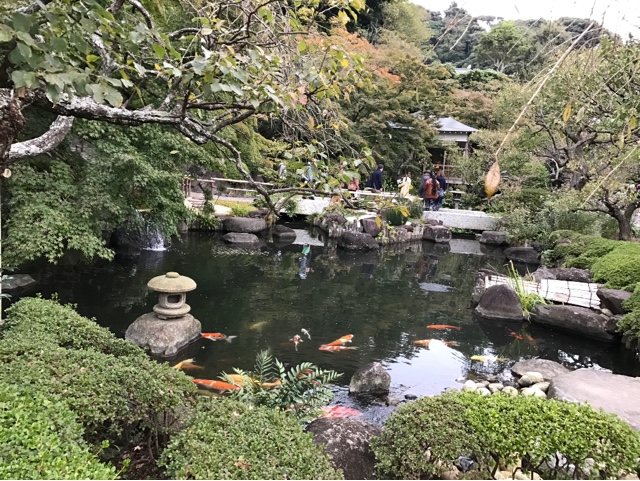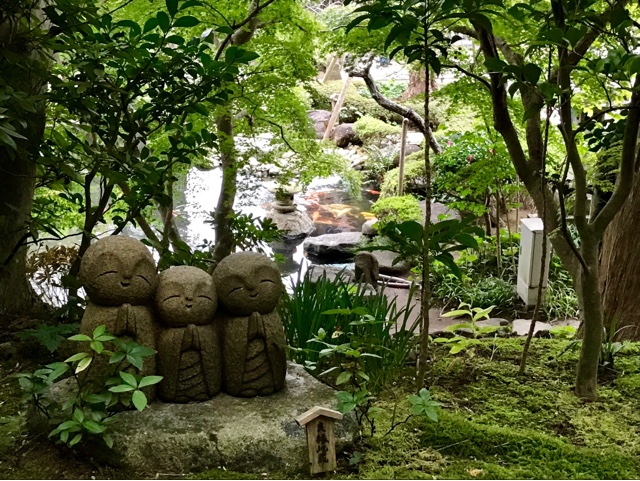There was nothing I wanted for today than to spend the day blissfully walking from one ancient temple with breathtaking landscapes to another, and that’s exactly what I got! It was overcast and noticeably cooler than yesterday, but it was still very nice to walk around.
We went to Tokyo Station and took the train there to Kita-Kamakura, the station just before Kamakura proper. The most common itinerary is to go to Kamakura Station, see the Great Buddha and Hasedera, then walk across town to see the temples, but I decided to mix it up a bit and do the visit the other way round. The train ride takes about 55 min. Actually, the train ride takes 54 minutes exactly, because Japanese trains are as punctual as you expect. Several times I’ve done the exercise of looking at my watch as a train’s arrival time approaches, and every time when the watch is about to strike the given minute you can start to see the train coming in the distance.
As you leave Kita-Kamakura station, the first temple (literally a two-minute walk) is Engakuji, a Zen Buddhist temple notable for its many different buildings arranged across a wide terrain. There were only a few tourists around; it was relatively early in the morning, so most tourists were probably either still on their way from Tokyo or at the Daibutsu, across town.
It has an enormous, dark wooden gate, and big pavilions with verandas overlooking quiet ponds. Here and there some of the many Japanese maple trees had begun turning colour, some to orange, some even to red. Keep going, maple trees!
Our next stop, Tokeiji, was also a stone’s throw away, across the train tracks. As we crossed a small stone bridge over a pond, a beautiful gray crane took flight. Hope this is a good sign for our longevity! (Then again, in the next temple over a giant black crow landed on top of the gate we were looking at, so who knows)
Tokeiji is a tiny, beautiful temple nestled in a small valley. It is notable because women who became nuns here in the Middle Ages could become divorced from their husbands, not exactly a common right at the time. I only discovered it last time because the tourism office recommended checking out the plum trees, which were in full bloom that week. It is less spectacular now without flowers, but it’s nevertheless an interesting visit and the gift shop has gorgeous stationery!
After that, we had to walk for about a quarter of an hour along a very narrow pavement while cars and trucks sped past us on the highway. Since this area is so hilly, people and cars have to huddle together along this meandering road. After several false starts in what turned out to be restaurants or shops, we succeeded in finding a café, albeit one that looked a bit like somebody’s living room, grand piano covered in frilly cloth included. The lady who ran the place was exceedingly nice and garnered me my first “Nihongo wa jozu desu ne!” of the trip, much to my pride. I made sure to reply “Mada, mada” so she wouldn’t think I was raised by wolves.
Kenchoji, our next destination, is also a zen monastery, apparently the oldest one in Japan, and features another gigantic wooden gate, an ancient Buddha statue, and a grove of juniper trees that are believed to be over seven hundred years old. All of these look very austere and imposing, but if you keep going past them there are beautiful black and white buildings with ornate golden doors. The place was busier than Tokeiji, where we’d had almost the entire place to ourselves.
From Kenchoji it was back to the precarious foothold of the sidewalk along the main road, which went through a huge tunnel (I have no recollection of the tunnel from last time, although I must have passed it since there’s no other way). Finally our efforts were rewarded when we arrived at Tsurugaoka Hachimangu, the first Shinto shrine of our visit. It rests on top of a forested hill and the bright red and white structures were a welcome sight after the sober dark wood of the Zen temples.
To our delight, today was some kind of festival or holiday, because lots of families were visiting the shrine with their small kids, all dressed in beautiful tiny kimonos. My first thought was that it must be shichi-go-san, the festival for kids who are seven, five and three years old, but looking on the internet that seems to be next week… Whatever the occasion, it was great to see the beautiful temple grounds while the kids in traditional dress posed for pictures. There was a family posing on a red bridge over a pond with a young boy bored out of his mind, and he perked up all of a sudden when he saw a squirrel darting across the bridge and up a tree.
Coming down Hachimangu on top of the hill, there are a set of stairs that lead down to the main avenue in the city of Kamakura, marked by great red torii on either side. From here the best way forward is to keep walking down Komachi-dori, to your right as you come down the hill; it’s a nice pedestrian street that connects this end of the town with Kamakura Station.
Komachi-dori is always packed with people, locals and tourists alike, and most stores and cafés cater to visitors, but nevertheless it’s a very amusing walk. Even the gift shops are for the most part tasteful, and people are so civilised that even when crowded, nobody’s pushy or obnoxious.
We looked for a place to have lunch around here that didn’t have long queues -the longest one of all turned out to be, believe it or not, the queue for a jewellery store- and settled for a self-proclaimed Italian restaurant off Komachi-dori. There were only two items on the menu and they were translated into English, but I still had to talk to the waitress in Japanese, because the translation was somewhat free:
“So, this dish that says bacon and onion with amatriciana sauce, that’s pasta with, right?” I asked.
“Hai!”, she said.
“And the other one, spaghetti with white bait?” I went out on a limb and hazarded, “Is that fish?”
“Yes,” she said, “Small fish.”
“Um,”
“Let’s have one of each!” my mother intervened, as I had a vision of what was coming.
It was indeed spaghetti with lots of tiny fish inside; now I know they’re called shirasu, and whitebait is actually a proper translation. Let’s just say that we like our plates to be strictly eye-free, so we made short work of the tomato pasta instead.
After lunch and a nice walk, browsing stores and stopping for dessert at a patisserie, we emerged at the train station and took a 10 min bus ride to the Daibutsu, the great Buddha of Kamakura. We learned that we have to touch in and also out with our Pasmo cards when getting on a bus, like with the subway.
The Daibutsu was still as impressive as I remembered it, and carries its 800 years well. The enclosure was busy with tourists still (it must have been around 15:00; pretty late for Kamakura sightseeing, because some temples close at 16:00), as indeed it probably always is, although I still think we avoided the worst of it. We crossed several monks who were making their way downhill.
From the Daibutsu, it was a short walk to Hasedera temple. It was no coincidence that I left the most fun visit for last; Hasedera is a delight to walk through, because it has so many different ambiances scattered over three different levels on the slopes of the mountain.
It has a beautiful pond with colourful koi, a cave with ancient stone carvings, a dry rock garden, jolly smiling statues, a veranda overlooking the entire bay of Kamakura, rows and rows of identical stone figures… Every ten paces you go up some steps or turn a corner and your entire surroundings change. This is why it’s so important to visit when the weather’s clear; you wouldn’t get to enjoy any of this if it rained!
Aside from the amazing garden, Hasedera also has ample halls where locals come to pray to a massive gilded statue of Kannon. Right outside there’s a terrace with signs warning about birds who swoop in to steal your food.
That’s as far as our legs would take us, so we took another bus back to the train station. After an entire day’s worth of walking up and down slopes and winding roads, the hour of train ride is actually a blessing! We took the chance at Tokyo Station to reserve our Shinkansen tickets to Kyoto, for Thursday. Reserving them at a desk with our JR passes took literally seconds, it was wonderful (also, achievement unlocked: carried out the entire process in Japanese!).
Tomorrow: last day in Tokyo! We must make sure we leave no loose ends!











